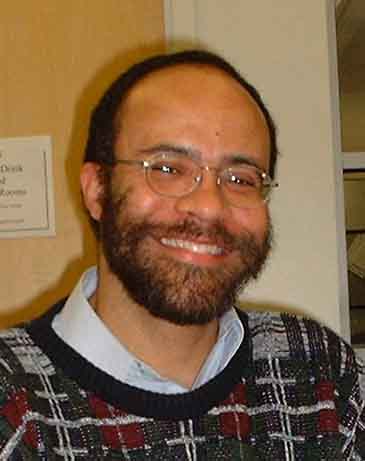Dean of Applied Biotechnology
North Valley & Mountain
Biotechnology Center
Back to ARC Institutional Report index

|
Interview with Jeffery O'Neal, Dean of Applied Biotechnology North Valley & Mountain
Biotechnology Center Back to ARC Institutional Report index |
 |
BIOTECHNOLOGY DEPT.
The Biotechnology Center operates under a grant from the Chancellor’s
Office.
Mission:
. Main thrust of the program is academic development. Additional goals:
· Teach biotechnology to faculty
· Provide workshops in the summer
· Provide outreach to some high schools
· Form liaisons with companies
· Get students and faculty placed in internships with companies.
· Create programs/curriculum
· Try to get faculty to teach more biotechnology/provide service for faculty
who are interested
· Promote biotechnology training in the region with other colleges
· Help companies find a qualified work force
Additional Services:
· Speakers who visit the campus to speak on various topics
· Food & Ag from UCD [this one is confusing in the interview…may be
an example of above]
· Conferences for students
· Newsletter and website
Work in conjunction with the Science Dept. at ARC. External contacts are emphasized (SACTO, SETCORPS [? Not sure how to spell, difficult to hear on the tape, you guys can correct!] UCDavis, UC Davis Connect, EconDev divisions.
External Options for ARC
· Contract Ed
o The company pays for the course
o Call Service (help desk)
· Ed>Net:
o operates across 6 different initiatives, including: Small Business,
Biotechnology, Advanced Transportation, International Business and Trade.
o There are 5 or 6 centers for these initiatives: identified areas where
colleges can help businesses or industry and enhance college activity.
COLLEGE IN GENERAL
FOCUS OF EXTERNAL PROGRAMS (OUTREACH):
1. Desire to create more connections between the community college and
business: encourage “cross-fertilization” where both
benefit.
2. Mandate: Attract more adjunct faculty from business for the college
3. Get faculty and students out doing internships in business
4. Work force training
5. Support the development of business in California
a. Ex: Helping business write business plans, developing accounting practices and
other good business practices
CAREER DEVELOPMENT FOR FACULTY
College is “pretty supportive” of career development. Provides opportunities for staff development. Active faculty association. “Administration is pretty supportive in terms of making things possible for the faculty.” There is room for innovation. “People are proposing new curriculum and ideas all the time. For instance: ‘bio-informatics’ is a cutting edge field [which is offered here].”
CURRICULUM ADOPTION PROCESS (NEW COURSES)
Two different processes for Academic courses. (Different for Voc Ed: not
covered)
1. Faculty member comes up with an idea and addresses the following issues in a
formal proposal:
a. Relevance
b. Scope: Who will benefit (AA or certificate)?
c. Need (Is it unique?)
d. How many classes will it entail?
e. Transferability to university
f. Future employment possibilities for students (Voc/Ed)
g. Syllabus
2. Department Review
3. Curriculum Review Board
a. Faculty from a variety of fields
b. VP of instruction
c. Total of 10-12 people
d. Make corrections/recommendations
e. Faculty member defends proposal
f. Three rounds with this board: “It’s a convoluted
process!”
4. Los Rios Approval
a. Usually a “rubber-stamp” process
5. State Approval (only for the following):
a. Certificate or degree programs
b. Mainly look at potential for competition with other campuses; avoiding
duplication
c. Impact on State resources
Another Option: “49’s”
Classes can be offered experimentally, without going through a formal acceptance
process (they’re listed as “49” in the class schedule instead of a
regular course #).
Dean can approve a course for this classification. Simpler process. Gives the faculty
member a chance to “test it out.” Can offer it this way for 1 or 2
semesters.
OFF-SITE COURSES
· High School Courses (“AP” type for college credit. Students
pay regular tuition fees [$11 per unit]).
o Purpose: offering education to the community in a location that is
nearby/convenient for the student.
o provides marketing for ARC in order to build enrollment [like they really need to
do that!!]
o Off-site locations help alleviate the problem of lack of space.
CONCERNS
· Diversity of the charter/mission
· Changing needs/goals of students/community
o Students very different 25 years ago: right out of high school, not quite
ready yet for the university, working part time
o Now, average student is 27 years old.
o More re-entry students
o A lot of post-graduates coming back for specialized training
o Work force training
o Businesses are now looking for employees who are flexible: variety of skills
(not just focused in one area)
o Remedial level of entry students
o ESL students
o Older students: may still not have skills (why they didn’t pursue
higher ed earlier)
o Students are more likely to be working full time and have children, in addition to
taking classes
· Growth
o 10% increase in student population this semester; 30% in last 5-6 years
o Staff increase of 20%
o Minor increase in support staff (administration, clerical, maintenance): not
keeping up with the increase in student growth
o Lack of funds for facilities to provide more classrooms/repairs
· Slow Process for Change within the College
o “The institution can be an enemy [when it comes to change].”
o Gears move more slowly in the committee process
· 6 months to get something started initially; the entire process can take up
to 2 years
· In business, things move more quickly: change can happen within 6
weeks
“ Within the college, there’s momentum in a certain direction. If you want to go off in a different direction (i.e., a new course, idea, or concept), the momentum is working against you.” (Acknowledgement that this happens because the college is dealing with public, not private, funds. It’s a “checks-and-balances” safeguard.)